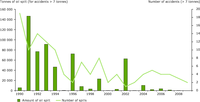
-

The map shows:
LEFT: Distribution of landslides with human consequences from AD 1300 to 2002. The size of the triangle indicates the intensity of the event.
RIGHT: Landslide susceptibility map of Italy.

-

-

-

-

The Revised Universal Soil Loss Equation (RUSLE) was applied to the whole alpine area. The model calculates annual soil loss (t ha-1 yr-1) based on Rainfall Erosivity Factor (MJ mm ha-1 h-1 yr, Soil Erodibility Factor (t ha h ha-1 MJ-1 mm-1, Slope length Factor (dimensionless), Slope Factor (dimensionless), Cover Management Factor (dimensionless), Human Practices aimed at erosion control. The output grid cell is 100

-

-

The map shows the percentage of organic carbon content in the surface horizon of soils in Europe.
The darker regions correspond to soils with high values of organic carbon. The darkest colours, especially in Estonia, Fennoscandinavia, Ireland and the United Kingdom, denote peatlands.

The figure shows statistically significant trends of ocean colour intensity 1998–2009 at the 95 % confidence level (Mann–Kendall test)

The figure shows change in winter oxidized nitrogen concentrations in coastal and open waters of the North East Atlantic, Baltic, Mediterranean and North Seas, 1985–2008

-

-

This map shows the mean annual concentrations of Nitrate (NO3) as mg/L NO3-N measured at Eionet-Water River monitoring stations during 2008. All data are annual means. For most countries these are based on measurements over the whole year, whereas some countries have samples only from the growing season (due to ice cover in winter)

The maps shows the mean annual orthophosphate concentrations (PO4-P) exceed 0.2 mg/l in some river basins across Europe

This map shows - for those countries that have reported data to the EEA – which of the triazine group of pesticides have been found in recent years in groundwater, on at least one sampling occasion, at a concentration greater than 0.1 µg/L, the standard under both the Groundwater and Drinking Water Directives. The data does not reflect the frequency with which the threshold has been exceeded.

-

The results were computed using the 2008 Critical Loads database hosted by the Coordination Centre for Effects (CCE).

AOT40 for crops are vegatation exposure related indicators and are based on rural background station observation only